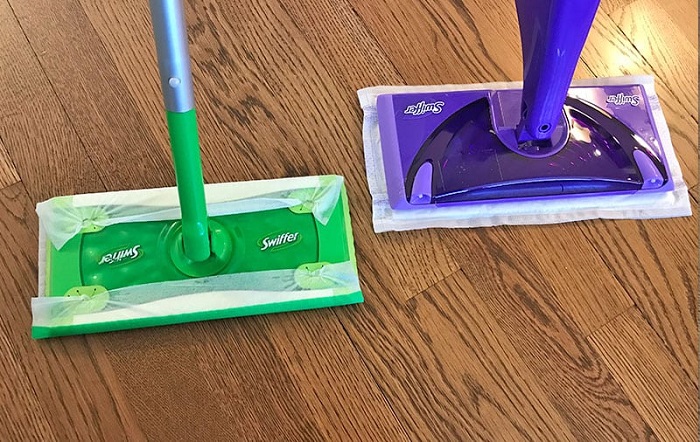
Linoleum rolls or planks are beautiful and fashionable, and they're significantly less expensive than other flooring options. However, if not correctly cared for, the long-lasting flooring can lose its lustre.
Laminate floors require some maintenance to keep them looking their best. A short sweep with a Swiffer or other dry mop appears to be a straightforward approach to pick up the dust and dirt that accumulates on the floor daily.
However, some laminate floor cleaning chemicals might cause more harm than good if applied inappropriately on the slippery surface.
To keep the brilliance of the non-porous material, use the suitable laminate floor cleaner and apply it with the proper technique.
Before we get started, it's essential to understand what a laminate floor is. The laminate floor is a multi-layer synthetic flooring made up of various materials that are pressed together.
It consists of four layers:
It is relatively simple to maintain your laminate floor, but laminate producers highly advise against using any wet steam on it. A Swiffer sweeper damp mop is a good option, according to experts.
Wet mops can be used regularly to scour the floor. On the other hand, water can leak between seams and cause laminate planks or tiles to curl. When using wet mops, always take caution and avoid letting water sit in puddles on the floor as you work around the room.
The best way to go is to clean laminate flooring with minimal wetness and the correct detergent. The right amount of detergent spray may be applied with a Swiffer Sweeper wet mop without allowing the water to linger too long on the laminate surface, causing damage.
It's one of the most common household cleaners, and it's also one of the most cost-effective for maintaining the lustre of laminate flooring. Vinegar is an excellent laminate floor cleaner since it leaves little residue.
Cleaning laminate floors with VinegarVinegar prevents grease and filth from lodging in the grooves and is difficult to remove. Whether used directly from the bottle or mixed with water, VinegarVinegar as a foundation will take up grime and loosen muck that can collect into any seams or dimples in the flooring without damaging the sheen.
One part vinegar to 2 parts warm water is a decent essential mix that can be tweaked based on the level of filth you need to remove.
This blend is gentle enough to use every day or every week. Increase the mixture to 1 cup of each and add 1/2 teaspoon of mild dishwashing detergent for filthy flooring. Using too much soap might leave a film on the floor or find its way into seams and cracks, making it difficult to remove.
A well-laid laminate floor can have a clean and glossy surface for decades when properly cared for and maintained. A dry mop can quickly remove all dirt tracked into a home and across the laminate flooring daily by children, pets, and visitors.
Cleaning the floor using a Swiffer Sweeper and a dry, untreated pad daily can remove dust without damaging the laminate. Dry mop pads that are treated with detergent, on the other hand, can leave a thin film behind. This layer can attract dust, making it more difficult to clean over time.
Everyone believes that a dry mop is the best way to clean laminate floors, but wet mops are the most effective. You can regularly use wet mops on laminate floors
to shine them, but you must pay care to them. Be cautious when using wet mops since standing water can damage the laminate floor if puddled for an extended period.
In addition, you can moisten the floor with a bit of detergent mixed with water and spray it, then clean it well. Despite the abundance of wet mops on the market, the Swiffer Sweeper Wet Mop is the best option.
Swiffer Sweeper Wet Mop is the appropriate application tool for successful floor cleaning; it's suited for all floors, including laminate, sealed tile, wood, etc.
On the other hand, homeowners should not use them on wooden boards, unfinished floors, non-sealed tiles and oil or waxed, or carpeted floors because they are water-sensitive. You should also be aware of how to use the spray mop.
The Swiffer WetJet is suitable for various flooring materials, including laminates. A Swiffer Sweeper wet mop provides the correct amount of moisture spray.
Swiffer Wetjet includes six heavy-duty mopping pads that can be refilled and are so beneficial that you don't even have to touch them and four original mopping pad refills.
One bottle of cleaning solution can supply the necessary volume of liquid spray without causing damage to your laminate flooring. There's no need to get a second spray bottle or bucket. You will receive four batteries, which will allow you to use this mop for an extended period.
It's bright and appealing, with a design that entices you to clean your Laminate Floor. When cleaning the floor quickly, the handle is quite pleasant and easy to move. Swiffer Wetjet is ideal for cleaning waterproof laminate floors as well.
Swiffer wet cloths are frequently asked if they can be used on laminate flooring. Yes, it's a fantastic idea because the wet materials give moisture to the cleaning process, making it move more smoothly. You can prevent damaging your floor or dulling the gloss that particular laminate floors have by cleaning it with these dampened pads.
If you have any wood-based furniture that has been varnished, lacquered, or otherwise protected, we at All In One Renovation would advise against using this product for fear of contacting water/moisture, which could ruin whatever finish has been applied in those areas by absorbing into them via microscopic pores where they cannot escape later.
 Call Now
Call Now